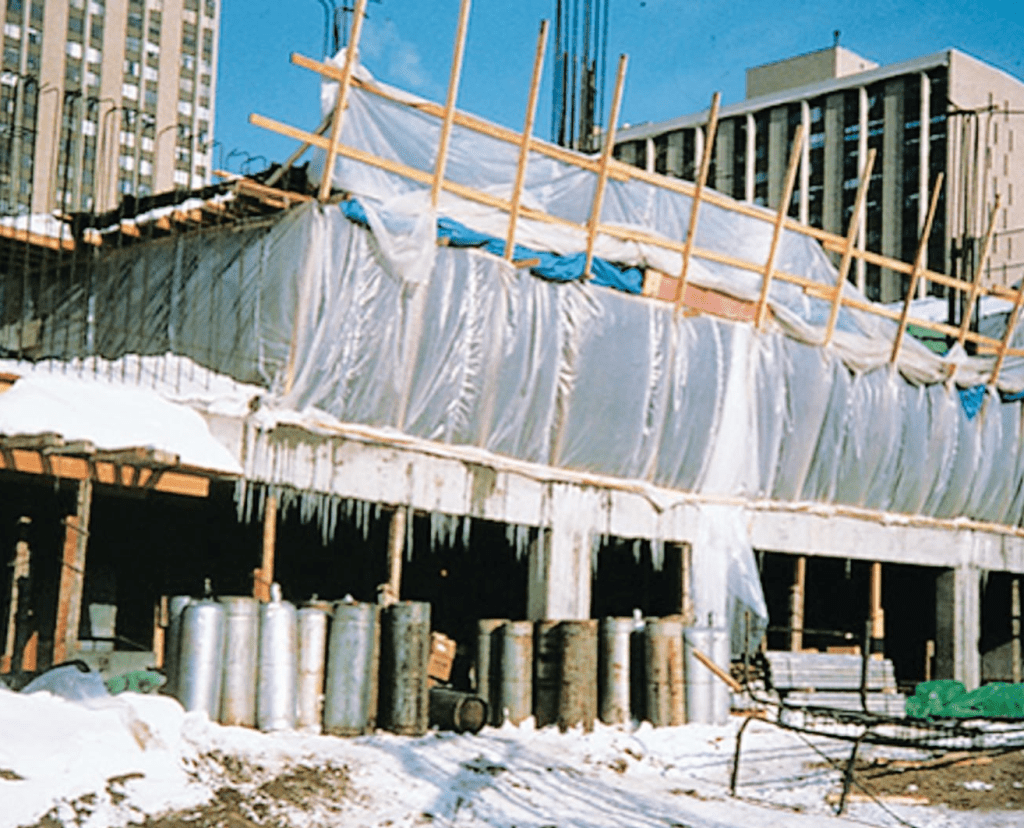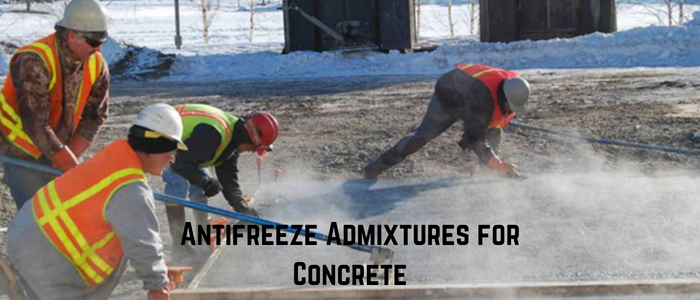Antifreeze Admixtures for Concrete
Casting concrete in cold weather is a difficult challenge that face contractors every year. Cold weather concreting refers to performing the construction activities in cold weather. These construction activities include placement, finishing, curing, and protection of concrete.
This article is one of our series on cold weather concreting. Check them here:
- COLD WEATHER CONCRETING: DEFINITION, ISSUES, AND PRECAUTIONS
- CONSTRUCTION PRACTICES FOR COLD WEATHER CONCRETING
- EFFECT OF COLD WEATHER ADMIXTURE SYSTEM ON CONCRETE [FRESH]
- EFFECT OF COLD WEATHER ADMIXTURE SYSTEM ON CONCRETE [HARDENED]
- USING NANO-MATERIALS IN COLD WEATHER CONCRETE
This article will describe the antifreeze admixtures that is added to concrete in cold weather. This type helps protection of concrete against the risk of freezing.
Why do not we want concrete to freeze?
The answer is because there are bad effects that can happen to concrete if it gets frozen.
Naturally, concrete has inner moisture that comes from the mixing water. Also, external moisture in the surrounding environment can cause moisture to get into concrete.
When concrete freezes, the water inside concrete pores also freezes. right?
The issue is that when ice forms, its volume increases by 9% compared to the original volume. The internal forces imposed on by this volume increase on the cement paste produce a considerable loss in the concrete’s compressive strength, which can go as low as 60%. Also, the bond strength between concrete and reinforcing bars can decrease by 70%.
There is an additional problem with fresh concrete freezing. If fresh concrete did not completely harden and develop its characteristic strength and get exposed to freezing, it will not set properly and it will lose considerable proportion of stress and cracks will develop that will significantly the permeability of concrete.
That is why we should take care to prevent concrete from freezing during the fresh state.
Methods for Cold Weather Concreting
There are two procedures that are typically followed in cold weather concreting:
1- Heating Enclosures
Setting up an enclosed enclosure surrounding the area of construction. This enclosure is heated to prevent the freezing of concrete.

The ingredients of concrete (such as water and aggregates) can also be heated.
2- Using Chemical Admixtures
This is second approach that depends on the incorporation of admixtures into concrete that prevent freezing and enhance the rate of strength gain after casting. The antifreeze admixtures are the topic of this article.
Antifreeze Admixtures for Concrete
Historically, calcium chloride was used as an accelerating admixtures to accelerate the rate of hydration to give higher early strength in low temperatures. However, calcium chloride was not effective below zero temperatures.
In addition, codes prevented all chloride-based admixtures since they are a main source of corrosion of reinforcing bars.
Research progressed in the field of cold weather concreting until reaching what we call “antifreeze admixtures”.
The antifreeze admixtures alter the physical characteristics of the concrete mix water. These work well in temperatures below -30oC and may significantly lower the freezing point of water. This may make it possible to extend the duration of the construction project.
Types of Antifreeze Admixtures
Antifreeze admixtures can be divided into two types depending on the function.
Type I: without acceleration feature
The first type of antifreeze admixtures refers to those products which lower the freezing point of the water but without working as accelerators to promote the setting and hardening. This includes chemicals, weak electrolytes, sodium nitrite and non-electrolytic organic compounds. For example, using 8% of sodium nitrite can save the water in liquid state at a temperature of -15oC .
Type II: with acceleration feature
This category includes the antifreeze admixtures that are actually a mix of two or more admixtures; each provides a specific feature to concrete. They can be binary, ternary, etc.
They can include sodium nitrite combined with calcium nitrite, nitrate mixed with urea, and so on.
This type also have a name which is “Cold Weather Admixture System”
They give the feature of reducing the freezing point and in addition, they accelerate the initial rate of strength gain (by accelerating the cement hydration process) .
Look at the below table that shows the difference in obtained compressive strengths at various ages (3, 7 and 28 days) between concrete with and without antifreeze admixtures.
| Temperature and days | Concrete with antifreeze admixtures. | Concrete without antifreeze admixtures. |
| Compressive strength (MPa) | ||
| -4oC (3 days) | 3.5 | 9.3 |
| -10oC (7 days) | 8.2 | 39.4 |
| -10oC (28 days) | 18.2 | 49.5 |
The obtained results show clearly the benefit of using the antifreeze admixtures.
By the way, it is feasible to combine additional admixtures such as superplasticizers with the antifreeze admixtures. The key benefit of this combination is that less water will be produced overall.
The mix’s freezable free water content will decrease as a result of the water reduction. The heat released by the early hydration processes is absorbed by this freezable water content, which also acts as a heat sink. As a result, there will be less antifreeze admixtures, which is cost-effective.
How to Select Antifreeze Admixtures?
The following criteria are used in the selection of antifreeze admixtures:
- The nature of the building
- The operational Condition
- Whether protective techniques used during winter concrete work
- Types of aggregate and cement
The operating components and the dose of antifreeze admixtures that are intended for use in the field must be tested in a lab.
Cold weather concreting does not prohibit the use of additional admixtures such as retarders and superplasticizers with antifreeze admixtures. Every employed admixture’s dose needs to be determined experimentally though.
Lab testing and trial batches makes you sure that you get the qualities that you want.
Benefits of Antifreeze admixtures
The antifreeze admixtures are advantageous for cold weather concreting and are straightforward to use technologically. The admixture aids in enhancing flexibility, cohesion, and elimination of cold joints and sand streaking. Compared to conventional steam curing or concrete enclosure processes, antifreeze admixtures are thought to offer significant cost savings.
The resistance of concrete to corrosion and frost action can be increased by combining antifreeze chemicals with water reducing agents or air-entraining agents.
